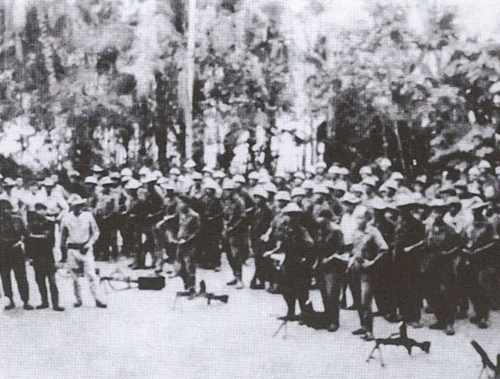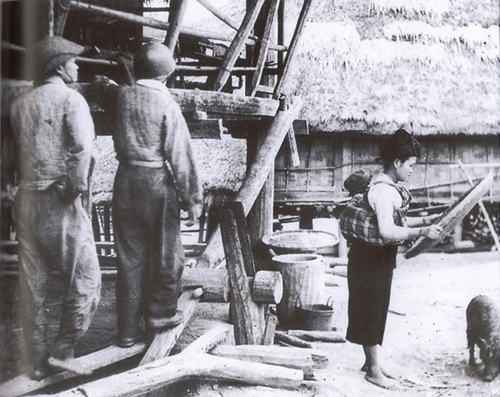The special combat alliance, together with the Vietnamese voluntary troops and experts operating in Laos, is one of the beautiful symbols of the two peoples.
“Political luggage”
During the national resistance war of the Lao people, tens of thousands of Vietnamese voluntary troops and advisers passed the Truong Son (Annamite) Mountain Range to come to Laos and implement international duties. Nguyen Van Nghiep, Deputy Head of the National Liaison Board for Vietnamese Voluntary Troops and Advisers in Laos, is one among them.
    |
 |
|
The Vietnam-Laos combat alliance in the early days of the resistance war against the French colonialists (Source: Vietnam News Publishing House) |
On August 19, 1948, 19-year-old boy Nghiep began his journey to Laos with his comrades of the first voluntary unit of Region 5. He still remembers that during the sent-off ceremony, comrade Pham Van Dong conveyed Uncle Ho’s advice, asking the Vietnamese voluntary troops to respect and love the Lao people like Vietnamese ones, treat the country like their second homeland. Uncle Ho’s advice has become “political luggage” for him and his comrades during their time in Laos. At the very first time in the country, Vietnamese troops met numerous difficulties such as language barrier, different cultural traditions and customs, lack of logistic supplies, or illnesses. However, they were then determined to learn the local language, traditions and customs, stay together with the Lao people and protect villages. They gradually built revolutionary bases in localities, organized guerrilla forces, and established authorities at all levels, Nghiep said.
A heroic song
The Vietnamese volunteer troops and advisers left their footsteps in all regions of Laos when they joined the national struggle for independence and freedom of the Lao people. Vietnamese “special international soldiers and comrades,” as called by Lao President Kaysone Phomvihane, promoted the spirit of proletarian internationalism, loved Lao people like loving their parents and siblings, took all hard work, gave favorable conditions to the Lao people, and stood side by side with the Lao people and troops in all battlefields and fronts with a bravery spirit. The blood of the Vietnamese and Lao soldiers permeated into the Truong Son Mountain Range and was mixed with the Mekong River’s water. Lao and Vietnamese mothers, whose sons sacrificed their lives for the national independence, shared similar sorrows and losses.
    |
 |
|
Vietnamese volunteer soldiers pound rice for Lao people. (Source: Vietnam News Publishing House) |
Not just blood and bones left behind, in the fight against the common enemy, they were ready to sacrifice for each other. There were Vietnamese soldiers who stayed forever in Laos, leaving their blood and bones on the land of Laos to bring freedom and peace to the people of the two countries.
According to Vietnamese Ambassador to Laos Nguyen Ba Hung, these examples of the Vietnam-Laos combat alliance, together with the bravery spirit and sacrifice of the Vietnamese volunteer troops and advisers for the Lao revolution were very special like the two countries’ relationship.
For Nghiep, he has devoted his whole-life for the Lao country and people. He spent 18 years studying about the Lao country, 25 years staying in Laos, including six years as a volunteer troop and the remaining 19 years as a Vietnamese adviser to help the country.
This became an unforgettable period in his life. Therefore, although he has retired for more than 30 years and is now 93 years old, his memories and feelings about the heroic history of the two nations remain intact. He said that he considers Laos his second homeland. This sentiment is sourced from the years when he implemented missions in Laos and received wholehearted care from the Lao people.
(To be continued…)
Translated by Trung Thanh